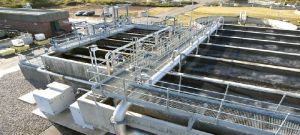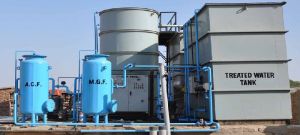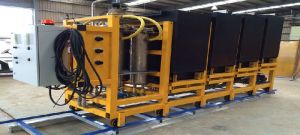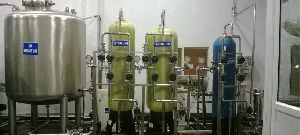
Zero Liquid Discharge Plant
Zero Liquid discharge refers to installation of facilities and system which will enable industrial effluent for absolute recycling of permeate and converting solute (dissolved organic and in-organic compounds/salts) into residue in the solid form by adopting method of concentration and thermal evaporation. ZLD will be recognized and certified based on two broad parameters that is, water consumption versus waste water re-used or recycled (permeate) and corresponding solids recovered (percent total dissolved / suspended solids in effluents).The significant industrial sectors like Sugar, Distilleries, Tanneries, Pulp & Paper, Textile, Dyeing, and Dairy would need special emphasis for enforcement of ZLD. It is important to mention that in the name of ZLD, no forceful injection into ground water table is to be tried 3 nor utilizing effluents / permeate for irrigation / or horticulture. ZLD would strictly means recycling treated effluent back for re-use in industrial / or domestic purpose but, exclude use / disposed in ambient environment. ZLD is applicable to industries having high BOD and COD load, colour bearing effluents, having metals, pesticides and other toxic / hazardous constituents. Applications Textile Industries Distilleries Pharma Industries. Chemical Industries Paper Industries Tannery Industries Dye & Dye Intermediaries Edible Oil Refineries Electroplating Industries Advantages Recovers valuable ingredients from effluent wastewater Reduces process water disposal cost Meets environmental permit targets Reliable and robust solutions allows focus on main production business
...more
ULTRA-FILTRATION PLANT
Our organization is a reputed manufacturer, exporter and supplier quality assuredIndustrial Ultrafiltration Systems. It is a latest and growing membrane based plant that is normally used for fine physical filtration. Offered systems are designed for a variety of industrial, commercial and municipal applications that requires high quality equipment with a fast delivery. These Industrial Ultrafiltration Systems are pre-engineered, pre-assembled and factory tested units minimize installation and start-up time. Provided systems can be easily availed from us in different technical options. Advantages : Suspended and solutes of high molecular weight are retained, while water and low molecular weight solutes pass through the membrane. Ultra filtration is applied in cross-flow or dead-end mode Separation in ultra filtration undergoes concentration polarization Stainless / carbon steel membrane tank and equipment frame Membrane and back pulse tank mounted on equipment frame Permeate, back pulse pumps, membrane aeration blowers and associated valving mounted on equipment frame Control panel with standard PLC and HMI interface mounted on equipment frame
...more
trickling filter
The terms trickle filter, trickling biofilter, biofilter, biological filter andbiological trickling filter are often used to refer to a trickling filter. These systems have also been described as roughing filters, intermittent filters, packed media bed filters, alternative septic systems, percolating filters, attached growth processes, and fixed film processes. The bio-film that develops in a trickling filter may become several millimetres thick and is typically a gelatinous matrix that contains many species of bacteria, and amoeboidprotozoa, annelids, round worms and insect larvae and many other micro fauna. This is very different from many other bio-films which may be less than 1 mm thick. Within the thickness of the biofilm both aerobic and anaerobic zones can exist supporting both oxidative and reductive biological processes Advantages Appropriate for small- to medium-sized communities. Very Efficient in removal of ammonia from waste water Low power consumption. Simple and reliable process that is suitable in areas where large tracts of land are not available.
...more
SUBMERGED AEROBIC FIXED FILM TECHNOLOGY
It is based on aerobic attached growth process and used in the secondary treatment of wastewater treatment plant. In this process raw sewage is introduced into the SAFF Reactor where for attached growth process takes place containing contains polymer based bio-media. The aerobic environment in the SAFF is achieved by the use of fine bubble diffused aeration equipments, which also serves to maintain the mixed liquor in a completely mixed regime. The mixture of new cells and old cells overflows into a secondary sedimentation tank where the cells are separated from the treated wastewater. A portion of the settled cells is recycled using the horizontal, non-clog, and flooded pumps to maintain the desired concentration of organisms in the SAFF reactor and the remaining portion is wasted to aerobic sludge digester-cum-thickener tank for further sludge treatment. Advantages No constant monitoring of MLSS required thus making it user friendly. No chance of occurring septic conditions due to power failure as it sustains microbial growth under irregular power supply conditions. Less maintenance as there is no moving parts. Less sludge generation hence reduced problem of sludge disposal. The fixed-film process will continually slough off outer layer(s) of dead bio film and continue to produce new microorganisms to meet the organic load. Low power consumption due to high oxygen transfer.
...more
Softening Plant
We are engaged in the manufacturing, exporting and supplying of superior quality Water Softening Plant that shows excellent performance in diverse Industrial applications. It is based on Ion Exchange Technology and comprises one vessel filled with strong acid cation exchange Resin. They are available in a range of diameters. We provide Industrial Water Softening Plant at very competitive price as compared to our counterparts. Advantages : Low power consumption Reduction of scales Durable Easy to operate
...more
SEWAGE WASTE WATER TREATMENT
This is a conventional process to treat the hospital wastewater. In this process the wastewater is treated in open tank called aeration tank and air is supplied either through fixed / floating surface aerator or air blower to provide oxygen for the aerobic microbes. Around 12-15 hour hydraulic retention time is provided for the treatment of wastewater. The microorganisms utilize the oxygen in the air and convert the organic matter into stabilized, low-energy compounds such as NO3, SO4, and CO3 and synthesize new bacterial cells. The overflow carried to the adjacent clarification system contains active microbes and is required to be recycled back to aeration tank to maintain specified critical performance rating parameter like MLSS and F/M ratio. Advantages BOD5 removal efficiency > 90%. User friendly. Require less skilled labour for operation and maintenance (O &M). Oxidation and nitrification achieved without chemicals. Maximum removal of suspended solids up to 97%. Most widely used wastewater treatment process because of non-availability of any othertechnology. Moderate land area. Ability to handle peak load and dilute toxic substances.
...more
SEQUENCING BATCH BIOREACTOR
One advantage of this orientation is flexibility of operation. The total time in the SBR is used to establish the size of system and can be related to the total volume of a conventional continuous-flow facility. As a result, the fraction of time devoted to a specific function in SBR is equivalent to some corresponding tank in a space oriented system. Therefore the relative tank volumes dedicated to , say aeration and sedimentation in the SBR can redistributed easily by adjusting the mechanism which controls the time ( and , therefore share the total volume) planned for either function. In conventional ASP, the relative tank volume is fixed and cannot be shared or redistributed as easily as in SBR. Advantages Single tank for reaction and settling. True batch mode of operation & can be operated as a time-based control system allowing continuous inflow of wastewater during all phases of the cycle. Ability to achieve biological oxidation, nitrification, de-nitrification, phosphorus removal and solid/liquid separation. Computer interface technologies, and advanced monitoring instrumentation capability, and ability to be operated remotely. Less labour required when operated automatically and computer controlled.
...more
Saff Media
It is based on aerobic attached growth process and used in the secondary treatment of wastewater treatment plant. In this process raw sewage is introduced into the SAFF Reactor where for attached growth process takes place containing contains polymer based bio-media. The aerobic environment in the SAFF is achieved by the use of fine bubble diffused aeration equipments, which also serves to maintain the mixed liquor in a completely mixed regime. The mixture of new cells and old cells overflows into a secondary sedimentation tank where the cells are separated from the treated wastewater. A portion of the settled cells is recycled using the horizontal, non-clog, and flooded pumps to maintain the desired concentration of organisms in the SAFF reactor and the remaining portion is wasted to aerobic sludge digester-cum-thickener tank for further sludge treatment.
...more
Reverse Osmosis Plant
Oxybee Solutions is a leading RO Plant Manufacturer in India. We maintain great professional working relationships with many top vendors in the water industry which ensures that we use nothing but the best parts and components for our reverse osmosis systems. Reverse osmosis(RO) is a membrane-technology filtration method that removes many types of large molecules and ions from solutions by applying pressure to the solution when it is on one side of a selective membrane. The result is that the solute is retained on the pressurized side of the membrane and the pure solvent is allowed to pass to the other side. To be "selective," this membrane should not allow large molecules or ions through the pores (holes), but should allow smaller components of the solution (such as the solvent) to pass freely. In the normal osmosis process, the solvent naturally moves from an area of low solute concentration (High Water Potential), through a membrane, to an area of high solute concentration (Low Water Potential). The movement of a pure solvent to equalize solute concentrations on each side of a membrane generates osmotic pressure. Applications of Reverse Osmosis Plant Ceramic Chemicals Dairy Fishing Food & Beverages Hospital Hotel Pharma Pulp & Paper Textile
...more
OXY-PROCESSOR TECHNOLOGY
The problem of purification of waste water containing various contaminants including organics, toxic compounds and ions, suspended solids, turbidity, color, heavy metals, fats, oil and grease is a challenging issue.Traditional treatment of effluents is based on physiochemical methods such as oil water separation and chemical coagulation, flocculation followed by biological treatment in activated sludge treatment plant. These methods have the disadvantages of requiring large space, use of chemicals and therefore their management, generates large quantity of sludge with greater quantity of bound water with attendant dewatering and disposal problems, require skilled man power to operate and maintain. The suspended oil can be separated by physical means, however it requires large retention time and space. Chemically stabilized oil water emulsion present a problem which requires chemical de-emulsification followed physiochemical precipitation.Much attention is recently paid to electrochemical processes because of the advantages of small foot print, minimal unit operations, eliminates chemical use and their management, less bound water sludge easy to dewater and ease of operation and maintenance. The choice of unit electrolytic processes and their sequences are effluent specific. There are various electrolytic processes which are designed with emphasis on each one of them to attend to a specific problem. These are Electro destabilization, Electrochemical de-emulsification, Electro oxidation, Electro coagulation and agglomeration, Electro flotation etc.
...more
Moving Bed Bio Reactor
The FBR process is the latest advance in attached growth aerobic biological treatment technology. FBR employs RING PAC MEDIA, neutrally buoyant bio film carrier elements, to achieve outstanding BOD/COD removal productivity from a compact bioreactor. In Fluidized Bed Reactors, the liquid to be treated is pumped through a bed of small media at a sufficient velocity to cause fluidization. In the fluidized state the media provide a large specific surface for attached biological growth and allow biomass concentrations in the range 10-40 kg/m3 to develop. For aerobic treatment processes the reactor is aerated. This is done by recalculating the liquid from the reactor to an oxygenator where air, or possibly oxygen, is bubbled. To overcome problems related to high re-circulation rates, needed when there is high oxygen demand in the reactor, the reactor might be aerated directly. The basis for the use of fluidized bed systems is the immobilization of bacteria on solid surfaces. Many species of bacteria (and also other microorganisms) have the ability for adhering to supporting matrices. In this process, a volume of Ring Pac media is immersed in water and is fluidized (kept in constant motion) through the movement of gas and liquid in the treatment reactor. As the media supports a biomass concentration several times that achievable in activated sludge systems, treatment is significantly more productive. Advantages The FBR requires very less hydraulic retention time (HRT) compared to an extended aeration or activated sludge process to perform the same BOD reduction duty. High resident biomass concentration, intense mass transfer conditions and aggressive biomass-sloughing action enable the process to rapidly respond to variations in process load Less footprint area required for installation. Less operation and maintenance cost during plant operations.
...more
Membrane Bioreactor
It is proposed to use Membrane Bio-Reactor (MBR) system working on the principle of filtration of activated sludge through the concept of using flat sheet type or hollow fibre type submerged membrane modules in bioreactors. The membranes in a MBR system are made from polymeric organics (PVDF, PE or PES) and assembled into units (modules, cassettes, stacks) with high packing density. Raw wastewater pre-treatment is important to sustain stable MBR performance and fine screening is essential operation. Advantages MBR is capable of meeting the most stringent effluent water quality standards. Membrane modules are back-flushable Yield 60-80% less sludge than conventional system Requires cleaning only once in 3 to 6 months. Maintain high MLSS No secondary clarifier, virtually no effluent suspended solids, no RAS recycling. It allows systems to be remotely operated and monitored, thus significantly reducing operator attendance. Sludge can be wasted directly from aeration tank
...more
FLUIDIZED AEROBIC BED REACTOR
The FBR process is the latest advance in attached growth aerobic biological treatment technology. FBR employs RING PAC MEDIA, neutrally buoyant bio film carrier elements, to achieve outstanding BOD/COD removal productivity from a compact bioreactor. In Fluidized Bed Reactors, the liquid to be treated is pumped through a bed of small media at a sufficient velocity to cause fluidization. In the fluidized state the media provide a large specific surface for attached biological growth and allow biomass concentrations in the range 10-40 kg/m3 to develop. For aerobic treatment processes the reactor is aerated. This is done by recalculating the liquid from the reactor to an oxygenator where air, or possibly oxygen, is bubbled. To overcome problems related to high re-circulation rates, needed when there is high oxygen demand in the reactor, the reactor might be aerated directly. The basis for the use of fluidized bed systems is the immobilization of bacteria on solid surfaces. Many species of bacteria (and also other microorganisms) have the ability for adhering to supporting matrices. In this process, a volume of Ring Pac media is immersed in water and is fluidized (kept in constant motion) through the movement of gas and liquid in the treatment reactor. As the media supports a biomass concentration several times that achievable in activated sludge systems, treatment is significantly more productive. Advantages The FBR requires very less hydraulic retention time (HRT) compared to an extended aeration or activated sludge process to perform the same BOD reduction duty. High resident biomass concentration, intense mass transfer conditions and aggressive biomass-sloughing action enable the process to rapidly respond to variations in process load Less footprint area required for installation. Less operation and maintenance cost during plant operations.
...more
Filter Vessels
Pressure Sand Filter is highly recommended for the removal of suspended solids & undissolved impurities like dust particles & heavy metals etc. PSF reduces turbidity. Pressure Sand Filter is an ideal solution for the systems with high sediment, silt, sand, and turbidity. The sand filters are specially designed to take care of the range of suspended impurities. Our unique design ensures the maximum utilization of the surface area, lesser pressure drop across the pressure bed and effective elimination of the impurities. Applications For Sand Filtration : Preparation of cooling water Treatment of waste water Drinking water Pre filtration for RO (membrane) systems Filtration of gray or surface water Salient Features : Efficient Turbidity and TSS Removal Filter up to 20 – 30 Microns FRP, MSRL, MSEP & SS Vessel available. Standard and effective multi grade sand media. Low Pressure drop across the vessel Air scouring available for high flow pressure vessel. Manual, Semi Automatic and Automatic features are provided
...more
Electro coagulation system
Electro coagulation is based on the science of electrolysis. Electrolysis involves passing of electricity through the effluent. The electric current destabilizes the dissolved colloidal particles and alters the charge on suspended particles to coagulate the pollutants (Electro Coagulation). These coagulants trap the gaseous products of Electrolysis Reaction and start floating in the water (Electro Floatation). A combination of Electro Coagulation and Electro Floatation removes the pollutants from the Effluent. Advantages Eliminates use of coagulating and flocculating chemicals, saves cost Low sludge volumes eases sludge disposal problems Easy to operate No moving parts, easy to maintain High pollution removal rates of more than 95 % in most of the cases, Effective Excellent performance to cost ratio, cost effective Small Foot Print, Saves precious land Noise & Odor Free, ideal for populated areas Can be customized to wide range of effluents
...more
DM Plant
Demineralized water also known as Deionized water, water that has had its mineral ions removed. Mineral ions such as cations of sodium, calcium, iron, copper, etc and anions such as chloride, sulphate, nitrate, etc are common ions present in water. Deionization is a physical process which uses specially-manufactured ion exchange resins which provides ion exchange site for the replacement of the mineral salts in water with water forming H+ and OH- ions. Because the majority of water impurities are dissolved salts, deionization produces a high purity water that is generally similar to distilled water, and this process is quick and without scale buildup.De-mineralization technology is the proven process for treatment of water. A DM Water System produces mineral free water by operating on the principles of ion exchange, Degasification, and polishing. Demineralized Water System finds wide application in the field of steam, power, process, and cooling.
...more
disinfection system
Controlling chemical and biological load in water is a challenge. With the ever stringent pollution norms, it is becoming important to use environment friendly technologies, which are effective. At Oxybee solutions a complete range of products and equipment, together with a commitment to service, enable us to provide our customers with a range of solutions specifically tailored to their needs.Mixed Oxidants generation system works on the principle of electrochemical activation of water. Electrochemical activation of water involves, Electroyzing a weak electrolyte, using a patented flow through electro chemical cell (FEM), at specific current, voltage, pressure, flow, pH & conductivity settings. The FEM electrolyses and then separates the solution coming out of the Anodic and Cathodic chambers. The solution coming out of the Anodic Chamber called Oxylite, is a mixture of oxidants. These oxidants contained in micro-bubbles exist in a metastable state. The presence of such a large number of oxidizing species has a synergic effect, imparting an extremely high oxidizing potential to Oxylite ,, making it a broad spectrum, fast acting, non toxic, eco friendly oxidant and biocide for universal application. Oxi-Lyte can replace all types of biocides like Chlorine, Chlorine Dioxide, HypoChlorite, Bromides, Ozone, UV etc.
...more
Demineralization Plant
Demineralization is the process of removing mineral salts from water by using the ion exchange process. Demineralised water is water completely free (or almost) of dissolved minerals as a result of one of the following processes : Distillation Deionization Membrane filtration (reverse osmosis or nanofiltration) Electrodyalisis Or other technologies. DEMINERALIZATION ( DM ) WATER TREATMENT PLANTS Demineralized water also known as Deionized water, water that has had its mineral ions removed. Mineral ions such as cations of sodium, calcium, iron, copper, etc and anions such as chloride, sulphate, nitrate, etc are common ions present in water. Deionization is a physical process which uses specially-manufactured ion exchange resins which provides ion exchange site for the replacement of the mineral salts in water with water forming H+ and OH- ions. Because the majority of water impurities are dissolved salts, deionization produces a high purity water that is generally similar to distilled water, and this process is quick and without scale buildup.De-mineralization technology is the proven process for treatment of water. A DM Water System produces mineral free water by operating on the principles of ion exchange, Degasification, and polishing. Demineralized Water System finds wide application in the field of steam, power, process, and cooling.
...moreBe first to Rate
Rate ThisOpening Hours